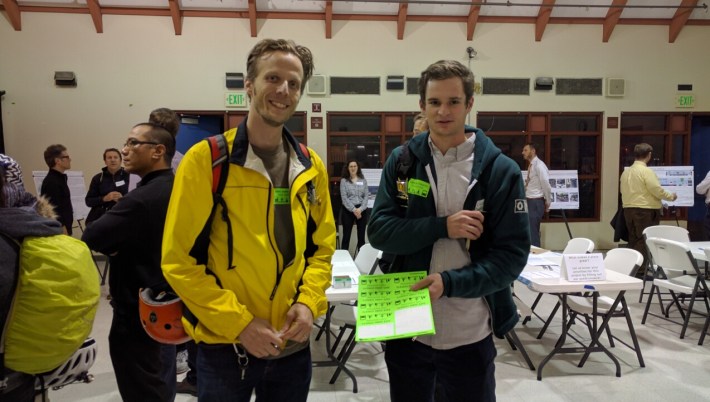SPUR Talk: Update on Geary Corridor Bus Rapid Transit
4:58 PM PST on November 28, 2016

A look at a short segment of Geary that will get true “BRT” upgrades. Image: CTA
The San Francisco County Transportation Authority (CTA), along with SFMTA, is completing its final environmental review for "Bus Rapid Transit" and other street improvements on Geary. Last week, the San Francisco Bay Area Planning and Urban Research Association (SPUR) held an update/discussion about this busy corridor.
As many Streetsblog readers already know, the planned improvements are primarily in response to the overcrowding on the 38 bus, which runs the length of Geary to downtown San Francisco. "At 52,000 daily riders, it's pretty crammed," said Colin Dental-Post, Transportation Planner with CTA. "They're stuck in traffic, so adding additional buses doesn’t necessarily work out...buses are so frequent they just bunch up...which results in further delays."

True enough. And as readers are no doubt aware, Geary has long been eyed as a corridor badly in need of transit improvements, going back to old BART plans that had a line going under Geary before turning up to the Golden Gate Bridge for a trip to Marin County. But every rail and subway proposal has fallen by the wayside.

The desire for a subway hasn't gone away. In fact, the SFMTA's own studies, done as part of the "Subway Master Plan," show that there's a clear demand--and one that no amount of bus improvements are likely to make go away.
"I don’t think anyone would resist a subway or BART out this way, but that’s an extraordinarily expensive endeavor," said Joel Ramos, Regional Planning Director with TransForm and an SFMTA director. "It’s taken ten years just to get to this phase, so if we drop all this and start working on a subway it will probably be 30 years before we see funding and all of it built out, which is too long for those of us who ride the 38."
Ramos likened getting on the 38 to playing a game of twister. "The reason why BRT is so great is because it’s so affordable--we can get results quickly. The project is expected to cost about $300 million.
"I want the buses to run smoothly, to run quicker, so I can go to the store, don’t have to wait half a day trying to get out there," said Kevin Stull of the Geary Citizens Advisory Committee, in praise of the project. But without center-running bus lanes and boarding islands for over two-thirds of the corridor, Streetsblog wonders how much improvement will actually materialize.
Peter Straus of the San Francisco Transit Riders, who was in the audience, rightfully complained about some of the compromises in the current plan. "We want to see a vision of full corridor development of center-lane BRT," he said. "We want full center lane for the full length."
According to CTA, there will only be center-running--true BRT--from Palm to 26th. West of that section, it will return to standard, mixed-flow operations, and from the Richmond to downtown it will run on bus-only, right side lanes--buses will continue to slog behind illegally stopped and turning cars through the most congested parts of downtown.
One reason for the limited length of the center-running lanes is Geary's tunneled sections. There was discussion about filling in the space created by the tunnels, or building stops inside the tunnel, but these were dropped for reasons of cost. So, in effect, the Geary BRT project is only "BRT" for less than two-miles. But as Streetsblog has previously reported, other compromises were dictated by merchants concerned about losing parking spaces.

Still, CTA is promising a 10-minute time savings for riders traveling the entire 6.5 mile route. And that, of course, is a huge improvement for anyone enduring a commute on it daily.
Nicole Ferrara of Walk San Francisco praised the project's safety improvements--highlighting how unsafe Geary is in its current configuration. "From a pedestrian perspective, you are eight times more likely to get hit on Geary than your average street in SF. When you walk there, you feel that," she said. "The Geary BRT is a major and important project because it will take a much more holistic, comprehensive approach." She pointed out that it will mean adding bulbouts and safer crossing places throughout the corridor.
Traffic calming will help, but, unfortunately, cyclists won't see any facilities coming to Geary.
At the SPUR presentation, officials said cyclists will have to use parallel streets. But as with Valencia and Mission, that formula gets people hurt. Even if there were a great bike route directly adjacent to Geary, at some point nearly every cyclist will need to cross Geary and/or use it for at least a block or two--and that assumes a cyclist is even familiar with which streets are safest.
The project includes only minor improvements for cyclists crossing Geary at Masonic, Steiner, Arguello, and Webster, as seen in the diagram below:

So just some paint and possibly some bike signals at a handful of intersections. To Streetsblog, this is unacceptable. At the very least, protected bike intersections have to become standard on any street as wide and heavily trafficked as Geary. Readers will recall that just last month cyclist Michael Vasquez was seriously injured in a crash at the intersection of Geary and Divisidaro. Intersections are the last places to be compromising.
Construction is slated to begin some improvements as early as next year, start major construction in 2019, and take about two years to complete.
For more events like these, visit SPUR’s events page.
Read More:
Stay in touch
Sign up for our free newsletter
More from Streetsblog San Francisco
SFMTA Starts West Portal Outreach
Agency presents plans to block traffic from crossing in front of the train station





